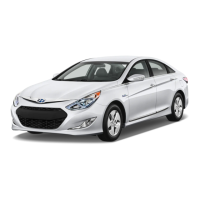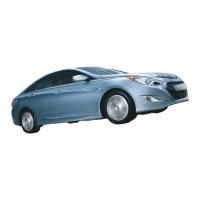
Do you have a question about the Hyundai Sonata Hybrid 2015 and is the answer not in the manual?
| Brand | Hyundai |
|---|---|
| Model | Sonata Hybrid 2015 |
| Category | Automobile |
| Language | English |
Explains how to effectively use the owner's manual for optimal vehicle understanding and safety.
Details the type of fuel, octane rating, and additives for optimal performance and engine health.
Provides guidance on initial vehicle operation for the first 600 miles for optimal performance and life.
Lists and explains warning lights and indicators on the instrument cluster for driver awareness.
Provides a diagram and list of interior controls and components with page references for details.
Details the layout and function of the instrument panel components, including cluster and controls.
Identifies key components in the engine compartment for maintenance and checks.
Illustrates and labels components within the vehicle's trunk area.
Explains proper use, restraint systems, and safety precautions for seat belts for all occupants.
Details importance and proper installation of child restraint systems, emphasizing rear seat safety.
Describes air bag system operation, components, and safety precautions.
Explains smart key operation, access, and starting precautions.
Details the operation of the theft-alarm system in its three stages: Armed, Theft-alarm, and Disarmed.
Details the operation of interior and exterior door lock controls, including auto lock/unlock features.
Instructions on opening and closing the trunk, including safety warnings.
Explains power window operation, auto functions, and the window lock switch.
Provides instructions for opening and closing the vehicle's hood, with safety warnings.
Explains how to open and close the fuel filler lid and refueling warnings.
Details the operation of the panorama sunroof, including sliding, tilting, and sunshade controls.
Describes the electric power steering system, its operation, and warning indicators.
Explains adjustment and features of inside and outside rearview mirrors, including auto-dimming and HomeLink.
Explains gauges, indicators, and display features of the instrument cluster.
Instructions for using climate control for windshield defogging and defrosting.
Covers essential pre-drive checks, including cleaning, tire condition, fluid levels, and safety warnings.
Details operation of the HEV system's start/stop button and its positions.
Explains automatic transaxle operation, shifting, sports mode, and shift lock override.
Covers power brake operation, warnings, parking brake, and good braking practices.
Explains ABS system function, benefits, and proper emergency braking usage.
Details ESC system function for vehicle stabilization and safety precautions.
Describes setting, adjusting, and canceling cruise control.
Provides tips for improving fuel economy through driving style and maintenance.
Advice for driving in hazardous conditions like snow, ice, mud, and during cornering.
Recommendations for winter driving, including snow tires and chain installation.
Actions for when the vehicle stalls in hazardous locations or intersections.
Instructions for checking tire pressure, TPMS malfunction indicator, and changing a tire.
Guidance for when the engine turns over but does not start, including checks.
Proper procedure for jump-starting a vehicle with battery warnings.
Steps to take if the engine overheats, including coolant and belt checks.
Instructions and cautions regarding towing the vehicle, including recommended methods.
Identifies engine compartment components for maintenance checks.
Outlines general maintenance, owner responsibilities, and authorized dealer services.
Lists checks and inspections for owners to ensure vehicle safety and dependability.
Details recommended maintenance services based on mileage and time intervals.
Covers tire care, inflation pressures, wear indicators, rotation, and replacement.
Explains fuse function for electrical protection and how to replace blown fuses.
Instructions and warnings for replacing exterior and interior light bulbs.
Lists key specifications for the vehicle's engine, including displacement and cylinders.
Details vehicle capacity weights, including gross vehicle weight and luggage capacity.
Provides specifications for tire sizes, inflation pressures, and lug nut torque.
Lists recommended fluids and their capacities for engine and other systems.
Explains the location and purpose of the VIN for registration.
Provides Hyundai Motor America regional contact information and safety advice.
Instructs on reporting vehicle defects to NHTSA and Hyundai.
Overview of the hybrid system, its components, and operation.
Explains the ECO level display and how driving habits affect its visualization.
Illustrates the different energy flow modes of the hybrid system.
Explains how the regenerative brake system charges the hybrid battery.












